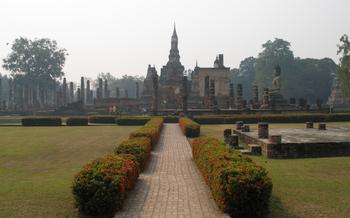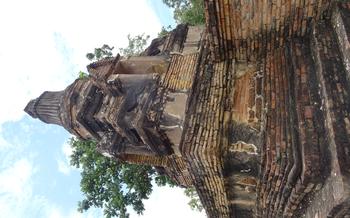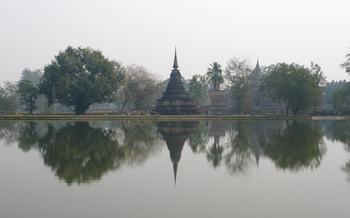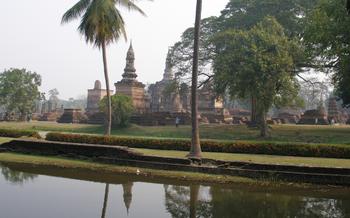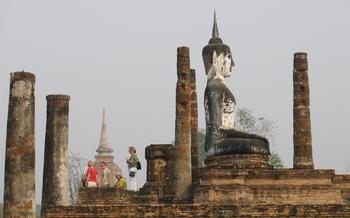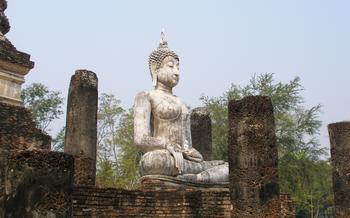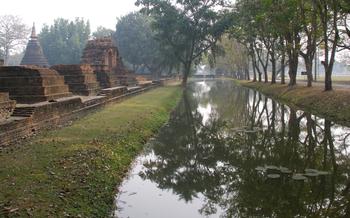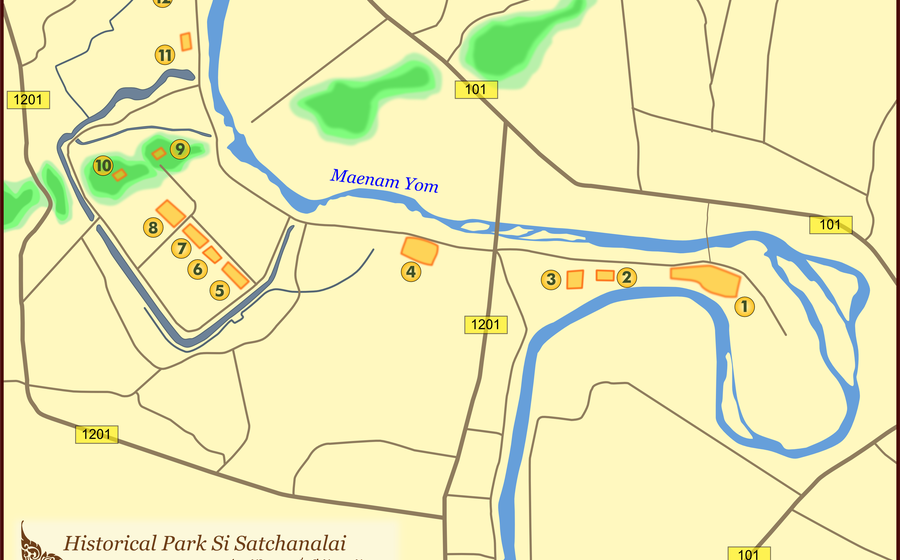
Wat Phra That Chom Chao
- Wat Phra That Chom Chao: A Historical Overview
- Location and Getting There
- Exploring the Temple Complex
- The Viharn and Mondop
- Surrounding Grounds and Gardens
- Ceremonies and Rituals
- Local Festivals and Events
- Local Offerings and Donations
- Photography and Videography
- Local Cuisine and Restaurants
- Accommodation and Where to Stay
- Insider Tip: Hidden Gems and Secret Spots
Wat Phra That Chom Chao: A Historical Overview
Nestled in the heart of Thailand's ancient capital, Sukhothai, Wat Phra That Chom Chao stands as a majestic testament to the kingdom's rich cultural heritage. Its history dates back to the 13th century, when King Sri Indraditya ordered its construction as a royal temple for the Sukhothai Kingdom. Over the centuries, Wat Phra That Chom Chao has undergone several renovations and expansions, reflecting the evolving architectural styles and religious significance of the era.
The temple's most striking feature is its grand chedi, an iconic symbol of Sukhothai architecture. Soaring high above the surrounding landscape, the chedi showcases exquisite craftsmanship and intricate details, embodying the pinnacle of Thai artistry during the Sukhothai period. Within the temple complex, visitors can marvel at the intricately carved viharn, or assembly hall, adorned with elegant pillars and housing a revered Buddha image.
Wat Phra That Chom Chao holds immense religious significance for Thai Buddhists. It is believed to be the site where the Buddha's relics were once enshrined, making it a sacred pilgrimage destination for devotees from across the country. The temple also serves as a center for religious ceremonies and rituals, attracting both monks and laypeople seeking spiritual guidance and blessings.
Throughout its storied history, Wat Phra That Chom Chao has witnessed numerous historical events and anecdotes that have shaped its legacy. From royal processions and festivals to battles and sieges, the temple has stood as a silent observer to the ebb and flow of time, its walls bearing witness to the triumphs and tribulations of the Sukhothai Kingdom.
Location and Getting There
Wat Phra That Chom Chao is situated in the heart of Sukhothai Historical Park, a UNESCO World Heritage Site renowned for its well-preserved ruins and ancient temples. The park is located approximately 420 kilometers north of Bangkok, the capital of Thailand. To reach Sukhothai, visitors can take a direct flight from Bangkok's Suvarnabhumi International Airport (BKK) to Sukhothai Airport (THS), which takes about an hour. Alternatively, one can take a train or bus from Bangkok's Northern Bus Terminal, which takes around 6-7 hours.
Once in Sukhothai, the most convenient way to get to Wat Phra That Chom Chao is by tuk-tuk, a three-wheeled motorized rickshaw. Tuk-tuks are readily available throughout the city and can be hired for a reasonable price. Visitors can also rent bicycles or motorbikes to explore the park at their own pace. Guided tours are also available, offering a more in-depth exploration of the temple's history and significance.
Exploring the Temple Complex
Wat Phra That Chom Chao's temple complex is a treasure trove of history, architecture, and religious significance. As you step through the gates, you'll be greeted by a serene and spacious courtyard, surrounded by various structures that each hold their own unique importance.
The centerpiece of the complex is the grand chedi, a towering monument that dominates the skyline. Its intricate design and symbolic significance make it a must-see for any visitor.
To the east of the chedi, you'll find the viharn, a large hall used for religious ceremonies and gatherings. Inside, you'll be captivated by the intricate murals depicting scenes from the life of Buddha and the history of the temple.
Adjacent to the viharn is the mondop, a square building that houses a large Buddha image. This structure is particularly significant for its historical value, as it is believed to date back to the original construction of the temple in the 14th century.
As you explore the temple complex, be sure to take your time and soak in the peaceful atmosphere. You'll find yourself drawn to the intricate details of the architecture, the serene beauty of the surroundings, and the palpable sense of history that permeates the air.
The Viharn and Mondop
The viharn and mondop are two other significant structures within the Wat Phra That Chom Chao complex. The viharn, also known as the assembly hall, is a rectangular building with a steeply pitched roof. It serves as a gathering place for monks and laypeople to participate in religious ceremonies and listen to teachings. The interior of the viharn is adorned with intricate murals depicting scenes from the life of Buddha and other Buddhist stories.
The mondop, on the other hand, is a square-shaped structure with a pyramidal roof. It is used for housing important religious objects, such as Buddha images and sacred relics. The mondop at Wat Phra That Chom Chao is particularly notable for its well-preserved murals, which provide valuable insights into the artistic and cultural traditions of the Sukhothai period.
Both the viharn and mondop are integral parts of the temple complex and contribute to its overall religious and cultural significance. Visitors are encouraged to explore these structures to gain a deeper understanding of Thai Buddhist architecture and iconography.
Surrounding Grounds and Gardens
In Thai temple architecture, landscaping and gardens hold immense significance, creating a serene and harmonious environment that complements the sacred structures. Wat Phra That Chom Chao boasts beautifully manicured gardens adorned with vibrant flowers, lush greenery, and towering trees, offering visitors a tranquil oasis amidst the historical grandeur of the temple.
Notable among the flora are the majestic rain trees, their expansive canopies providing shade and a sense of tranquility. Visitors can find peaceful spots beneath these trees, perfect for meditation and contemplation, immersing themselves in the serene atmosphere of the temple grounds.
The gardens also feature a variety of colorful flowers, adding a touch of vibrancy to the landscape. Bougainvilleas, with their vibrant purple blooms, contrast beautifully with the lush green foliage, while frangipani trees, known for their delicate white flowers and sweet fragrance, fill the air with a delightful aroma.
Photographers will find ample opportunities to capture stunning shots within the temple's gardens. The vibrant colors and textures, combined with the serene atmosphere, create a picturesque backdrop for capturing the essence of Wat Phra That Chom Chao.
Ceremonies and Rituals
Wat Phra That Chom Chao hosts significant ceremonies and rituals that offer visitors a glimpse into the vibrant spiritual life of Thai Buddhism. One of the most important ceremonies is the Kathin ceremony, held annually during October or November. During this ceremony, monks receive new robes and other essential items offered by devotees. The temple grounds come alive with colorful processions, chanting monks, and the distribution of merits.
Another important ritual is the Tak Bat, a daily morning alms offering. Devotees gather at the temple before sunrise, carrying food offerings in decorated bowls. As the monks emerge from the temple, they walk in a single file, receiving offerings from the faithful. This ritual not only provides sustenance to the monks but also strengthens the bond between the temple and the community.
Visitors are welcome to observe these ceremonies and rituals, but it is important to be respectful and mindful of the religious significance of these events. Appropriate attire and behavior are expected, and visitors should refrain from talking or making loud noises during the ceremonies. Observing these rituals is a unique opportunity to experience the deep spirituality and devotion that characterize Thai Buddhist culture.
Local Festivals and Events
Wat Phra That Chom Chao hosts several significant festivals and events throughout the year that showcase the rich cultural heritage of Sukhothai. The most prominent of these is the Sukhothai Historical Fair, held annually in January or February. This grand festival celebrates the founding of the Sukhothai Kingdom and features colorful processions, traditional performances, and lively markets.
Another notable event is the Loi Krathong festival, which takes place in November. During this festival, locals gather at the temple to release beautifully decorated krathongs, or floating baskets, into the moat surrounding the temple. This ritual symbolizes letting go of past grievances and bad luck and is a mesmerizing sight to behold.
Visitors planning their trip around these special occasions can immerse themselves in the vibrant local culture, witness unique traditions, and capture stunning photographs of the temple adorned with festive decorations.
Local Offerings and Donations
In Thai Buddhist culture, making offerings and donations is a significant way to show reverence and support to the temple and its monks. At Wat Phra That Chom Chao, visitors are welcome to participate in this practice as a sign of respect and to contribute to the temple's upkeep and maintenance.
Offerings typically consist of flowers, candles, incense sticks, or food items. These items are placed at designated altars or shrines within the temple complex. When making an offering, it is customary to kneel or sit in a respectful posture and offer a prayer or chant.
Donating money is another common way to support the temple. Donation boxes are usually located near the main entrance or in the viharn. Visitors can make donations in any amount, and all contributions are gratefully received.
By participating in offerings and donations, visitors not only contribute to the preservation of this sacred site but also gain a deeper understanding of Thai Buddhist traditions and customs. It is a meaningful way to connect with the local culture and show appreciation for the beauty and tranquility of Wat Phra That Chom Chao.
*Remember to be mindful and respectful when making offerings or donations. Always observe proper etiquette and refrain from touching or disturbing any religious objects or statues.
Photography and Videography
When visiting Wat Phra That Chom Chao, it's important to be mindful of the temple's sacred nature and respect the privacy of other visitors. Photography and videography are generally allowed, but there are some guidelines to follow.
-
Respect the Privacy of Others: Avoid taking photos or videos of people without their permission, especially during ceremonies or rituals. Always ask before capturing someone's image, and be prepared to respect their wishes if they decline.
-
Capture the Essence: Focus on capturing the architectural beauty, intricate details, and serene atmosphere of the temple complex. Experiment with different angles and compositions to showcase the temple's unique features.
-
Avoid Flash and Tripods: To minimize disruptions, avoid using flash photography or setting up tripods, as they can be distracting to other visitors and detract from the spiritual ambiance of the temple.
-
Document and Share: Use your photography and videography skills to document the temple's beauty and share your experiences with others. Consider creating a blog post, social media album, or travel video to showcase the wonders of Wat Phra That Chom Chao to the world.
Local Cuisine and Restaurants
When visiting Wat Phra That Chom Chao, be sure to sample the delectable local cuisine of Sukhothai. The province is renowned for its unique and flavorful dishes, influenced by both Thai and Khmer culinary traditions.
For a truly authentic experience, try the Khao Soi Sukhothai, a rich and creamy coconut curry noodle soup with egg noodles, chicken or beef, and a variety of fresh vegetables. Another must-try is the Pad Thai Sukhothai, a stir-fried rice noodle dish with your choice of protein, eggs, bean sprouts, and a tangy tamarind sauce.
Sukhothai is also famous for its sweets, particularly the Khanom Mo Kaeng, a sweet sticky rice cake filled with a mung bean paste and topped with coconut cream. For a refreshing treat, try the Lod Chong Sukhothai, a shaved ice dessert with green rice noodles, sweet syrup, and coconut milk.
To savor these local delicacies, head to one of the many restaurants and eateries in the vicinity of the temple. For a casual and affordable meal, try the Sukhothai Night Market, where you can find a wide variety of street food vendors selling everything from grilled meats to fresh seafood.
For a more upscale dining experience, visit one of the many restaurants in the old city of Sukhothai. The Sukhothai Restaurant offers a refined take on traditional Thai cuisine, while The Legendha Sukhothai serves innovative dishes inspired by the region's rich history.
No matter where you choose to dine, be sure to embrace the local food culture and try some of the unique and delicious dishes that Sukhothai has to offer.
Accommodation and Where to Stay
When planning your visit to Wat Phra That Chom Chao, finding suitable accommodation nearby is essential. Sukhothai offers a range of options to suit different budgets and preferences.
For a truly immersive experience, consider staying in a traditional Thai-style guesthouse or homestay. These charming accommodations often provide a glimpse into local life and culture, allowing you to connect with the community. Look for guesthouses that offer clean and comfortable rooms, friendly service, and perhaps even opportunities to learn about Thai cooking or traditional crafts.
For those seeking more modern conveniences, several hotels are located within easy reach of the temple. These hotels typically offer a range of amenities, including air conditioning, private bathrooms, and on-site restaurants.
To find the best deals on accommodation, it's advisable to book in advance, especially if you're visiting during peak season. Online booking platforms and travel agents can help you compare prices and find the perfect place to stay.
No matter your choice of accommodation, ensure it's conveniently located for exploring Wat Phra That Chom Chao and other attractions in Sukhothai. This will allow you to make the most of your time in this fascinating historical city.
Insider Tip: Hidden Gems and Secret Spots
Beyond the main attractions of Wat Phra That Chom Chao, there are hidden gems and secret spots waiting to be discovered by curious explorers. One such gem is the ancient reclining Buddha statue nestled in a tranquil corner of the temple grounds. With its serene expression and intricate carvings, this statue offers a glimpse into the rich artistic heritage of Sukhothai.
For a unique perspective, climb the narrow staircase leading to the top of the chedi. From this vantage point, you'll be rewarded with panoramic views of the temple complex, the surrounding countryside, and the distant mountains. The climb is challenging, but the breathtaking views make it worthwhile.
Another hidden spot is the meditation garden, located behind the viharn. This serene space invites visitors to find inner peace and tranquility amidst the temple's sacred grounds. With its lush greenery, fragrant flowers, and gentle breeze, the meditation garden is an oasis of calm and contemplation.
Finally, don't miss the ancient bell hanging near the entrance of the temple. This centuries-old bell holds a special significance for local devotees, who believe that ringing it brings good fortune and blessings. Take a moment to strike the bell and make a wish, adding your voice to the chorus of prayers that have echoed through the temple grounds for generations.

